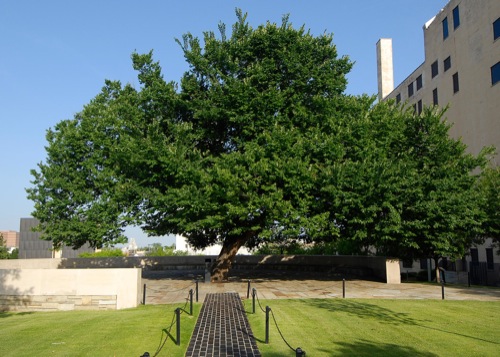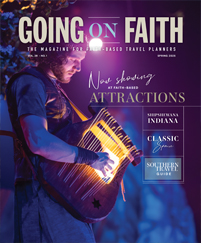
Courtesy OKC National Monument
Oklahoma City National Memorial
[ Oklahoma City ]
On the morning of April 19, 1995, Oklahoma City was changed forever when a bomb blast tore through the Alfred P. Murrah Building, killing 168 people. Today, the Oklahoma City National Memorial is a reminder of the brutality of evil and the healing power of hope and faith.
“The memorial is a celebration of life. We celebrate life by telling the stories of victims, investigators, chaplains and others involved,” said Kari Watkins, Oklahoma City National Memorial and Museum executive director. “They talk about how they dealt with tragedy and how they share a common faith that has helped to get us through this.”
The place where the Murrah building once stood is now dotted with a bronze and glass chair for each person who died in the tragedy. Each carries a similar design, but no two are alike. At night, the chairs are illuminated, creating a hauntingly beautiful remembrance.
Inside the museum, exhibits show life before the bombing and an audiotape of the moment of the blast, and then the story of the aftermath unfolds, including the carnage, the recovery, the investigation and the trial of the perpetrators.
In preparation for the 20th anniversary, an enclosed glass balcony will be created on the second floor of the museum that will allow visitors to view the memorial from a new vantage point. New artifacts and exhibits will also be added, among them interviews with the attorneys from the Timothy McVeigh and Terry Nichols trials.
Fort McHenry National Monument and Historic Shrine
[ Baltimore ]
Fort McHenry’s strategic position on the Baltimore Bay has given it an important role in conflicts through our nation’s history, but its most important contribution to American history came through poetry. The defense of the fort against the British during the Battle of Baltimore in 1814 was the inspiration for a poem written by Frances Scott Key that became “The Star-Spangled Banner.”
“Even today, you can go up on the rampart, look down on the river and imagine seeing the British fleet,” said Jim Bailey, ranger at Fort McHenry. “While the picture has changed somewhat, when visitors stop on the ramparts and listen, they will hear something that hasn’t changed in almost 200 years — the flapping of the stars and stripes. That in itself is worth the trip to experience.”
A new visitors center opened in early 2011 and features three exhibits and an introductory film. One exhibit looks at the fort over time, from its role in the War of 1812 through World War II. Another exhibit examines the personal significance of the national anthem to Key, giving visitors an interactive look at the text to find out what each word and section of the poem means. The exhibit makes the national anthem more understandable and uncovers the poem’s spiritual content.
“Key was a devout Episcopalian, and you can see in the fourth verse of the national anthem, he gives credit to a higher power,” said Bailey. “As a man of faith, he’s saying what worked in Baltimore can work in the future: stand together, fight for justice, and trust in a higher power, which would result in the star-spangled banner waving in the future.”
Groups can help raise the flag at the fort at 9:30 a.m. or help lower it at 4:30 p.m.
www.nps.gov/fomc
Martin Luther King Jr. Memorial
[ Washington, D.C. ]
Just over a year old, the Martin Luther King Jr. Memorial was dedicated on August 28, 2011, the 48th anniversary of the March on Washington for Jobs and Freedom. Sitting among the cherry trees by the Tidal Basin in the National Mall, the King memorial is the first national memorial to honor both a nonpresident and a man of color.
“The placement of the Martin Luther King Jr. National Memorial isn’t an accident,” said Carol Johnson, public affairs specialist at the National Mall. “It creates a ‘line of leadership’ from the Lincoln Memorial, where Martin Luther King Jr. gave his ‘I Have A Dream’ speech, to the Jefferson Memorial, highlighting Dr. King’s important role in broadening the meaning of democracy in America.”
The symbolism doesn’t stop at its placement; the monument itself also holds great significance. The 30-foot-high sculpture was carved out of white granite and bears the quote, “Out of the mountain of despair, a stone of hope” from King’s famous “I Have a Dream” speech. King’s image is sculpted into this “stone of hope,” which emerges from two boulders that symbolize the mountain of despair. A crescent-shaped stone wall features a number of engraved quotations from the reverend’s sermons and speeches.










